Physical Address
304 North Cardinal St.
Dorchester Center, MA 02124
Benign extraosseous cartilaginous lesions are uncommon and usually present as tumorlike masses. In the past, the term soft part chondroma or extraskeletal chondroma was used arbitrarily for small, well-defined, solitary nodules of hyaline cartilage that are unattached to bone and occur primarily in the distal extremities (especially the fingers and hand). These lesions, however, must be distinguished from the cartilaginous rests of branchial origin (usually found in the soft tissues of the lateral neck in infants and small children), as well as from the metaplastic cartilage encountered in some benign lipomatous (chondroid lipoma) and fibromatous (calcifying aponeurotic fibroma) neoplasms. They must also be distinguished from multiple cartilaginous nodules in the synovium (synovial chondromatosis), the myxochondroid metaplastic process that characteristically occurs in the plantar foot, and the cartilage found in myositis ossificans and its variants.
Chondrosarcomas also occur as primary soft tissue neoplasms, although much less often than primary chondrosarcomas of bone, and are of two types: extraskeletal myxoid chondrosarcoma and mesenchymal chondrosarcoma . Both represent translocation-associated sarcomas, but there is actually little evidence for true chondroid differentiation in extraskeletal myxoid chrondrosarcoma. Therefore, it is fully discussed in the section on tumors of uncertain type ( Chapter 33 ).
Well-differentiated extraosseous chondrosarcomas resembling hyaline cartilage are rare. In fact, if this tumor is encountered in soft tissue, it is more likely an extension or metastasis of a bone tumor rather than a primary soft tissue neoplasm. Well-differentiated chondrosarcomas do arise from the synovium (sometimes secondary to synovial chondromatosis) and from the periosteum (periosteal chondrosarcoma). They also appear following radiation therapy or injection of radioactive material, usually after a latent period of many years. Rare examples of chondrosarcoma also occur in parenchymal organs. In some locations (e.g., bladder), they usually represent part of a carcinosarcoma.
This chapter also addresses soft tissue lesions with osseous differentiation, including myositis ossificans and related nonneoplastic, heterotopic ossifications; fibrodysplasia (myositis) ossificans progressiva (FOP); and extraskeletal osteosarcoma.
Myositis ossificans , by far the most common of these lesions, is a localized, self-limiting ossifying process that usually follows mechanical trauma. Identical lesions also occur in individuals with no apparent history of preceding injury, and in some of these cases an infectious process has been suggested as a possible cause or initiating factor. Although most of these lesions originate in muscle tissue, morphologically similar proliferations also arise in the subcutis, tendons, fasciae, and periosteum. Depending on their location, these heterotopic ossifications have been variously classified as panniculitis ossificans , fasciitis ossificans , florid reactive periostitis , and fibroosseous pseudotumor of digits .
Not further discussed in the chapter are other, rare heterotopic ossifications that occur after various types of soft tissue injury. These lesions have been described in surgical scars (particularly those of the abdomen), in burns, in association with dislocations of the elbow and other joints, and total hip arthroplasty. Repeated minor soft tissue trauma is also the cause of the drill bone or shooter bone in the deltoid and pectoralis muscles, the rider bone in the adductor muscles of the thigh, and the shoemaker’s bone in the rectus muscle of the lower abdominal wall—all lesions rarely encountered today but repeatedly described in the earlier literature.
In addition to these more deeply seated lesions, localized bone formations in the dermis and subcutis are not particularly rare. They may be solitary or multiple, and they can occur spontaneously or in connection with a variety of neoplastic (e.g., linear basal cell nevus, basal cell carcinoma, chondroid syringoma, calcifying pilomatricoma) and nonneoplastic (e.g., scars, acne, puncture wounds, injections, organizing hematomas, pseudohypoparathyroidism, dermatomyositis) processes. Many of these lesions have been reported as osteoma cutis , but they too seem to be products of metaplasia rather than neoplasia.
Fibrodysplasia ossificans progressiva (myositis ossificans progressiva) is a heritable disorder in which massive crippling ossification occurs following diffuse fibroblastic proliferation involving the muscle and associated soft tissues (especially those of the back, shoulder, and neck). The process has its onset during early childhood and follows a relentless clinical course with total disability in its later stages. Microscopically, the early phase of the lesion may be confused with fibromatosis, but this process can be definitively identified radiographically in almost all cases by the presence of microdactylia and other malformations of the hands and feet.
Extraskeletal osteosarcoma is a highly malignant tumor that afflicts a much older age group than osteosarcoma of bone. Occasionally, it occurs in radiation-damaged tissues. Although there are case reports of myositis ossificans transforming into extraskeletal osteosarcoma, this is vanishingly rare.
Extraskeletal chondroma is a benign cartilaginous tumor that occurs predominantly in the hands and feet. Its variable histologic appearance can occasionally lead to a mistaken diagnosis of chondrosarcoma. There are two large series of this entity: 70 cases from the Mayo Clinic and 104 cases from the Armed Forces Institute of Pathology (AFIP) archives.
The tumor occurs primarily in the soft tissues of the hands and feet, usually with no connection to the underlying bone. The most common site is the fingers, where more than 80% are found. Less frequent sites include the hands, toes, feet, and trunk; unusual cases have been described in the auricle, bladder, and fallopian tube, among others. Extraskeletal chondroma grows as a slowly enlarging nodule that seldom causes pain or tenderness. The tumor mainly affects adults 30 to 60 years old (with a slight male predominance) and is rare in children. Almost all are solitary, although bilateral cases have been reported. The association of pulmonary chondroma, gastric epithelioid stromal tumor, and extraadrenal paraganglioma is known as Carney triad (see Chapter 31 ).
Radiographically, the lesion is well demarcated and does not involve bone, although some tumors cause compression deformities or bone erosion. Discrete, irregular, ringlike, or curvilinear calcifications are often demonstrable ( Fig. 30.1 ).
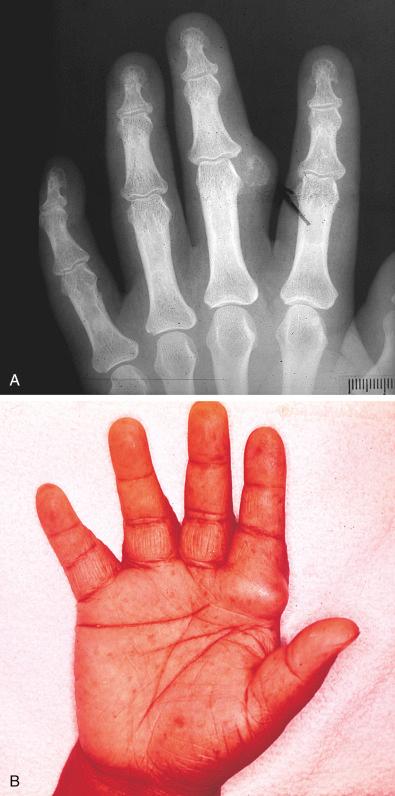
Extraskeletal chondromas are firm, well-demarcated, oval-round masses. Occasionally, they are soft or friable with focal cystic change. Almost all are small, seldom exceeding 3 cm in greatest diameter. They may be attached to the tendon or tendon sheath. Microscopically, they vary in appearance. About two-thirds consist of mature hyaline cartilage arranged in distinct lobules with sharp borders ( Figs. 30.2 to 30.5 ). Some are altered by focal fibrosis ( fibrochondroma ) or ossification ( osteochondroma ); others show myxoid change ( myxochondroma ), sometimes together with focal hemorrhage. About one-third display focal or diffuse calcification, which usually represents a late feature that may completely obscure the cartilaginous nature of the tumor and mimic tumoral calcinosis. With a granular, floccular, or crystalline appearance, the calcified material often outlines the contours of the chondrocytes in a lacelike pattern. The calcification tends to be more pronounced in the center than at the periphery of the lobule. Calcium pyrophosphate crystals may be seen, but do not indicate systemic pseudogout. Calcification is often accompanied by cellular degeneration and necrosis, which accounts for the softened gross appearance of some of these tumors. Cells with periodic acid–Schiff–positive, diastase-resistant, intracytoplasmic hyaline globules, possibly representing a glycoproteinaceous secretory product, may be occasionally encountered.
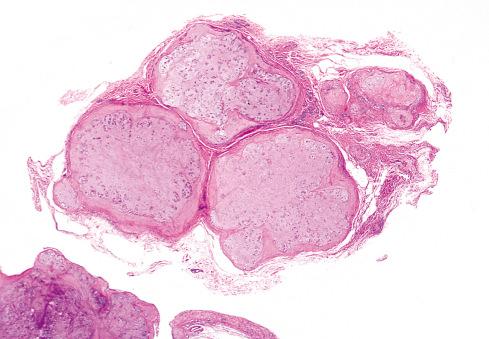
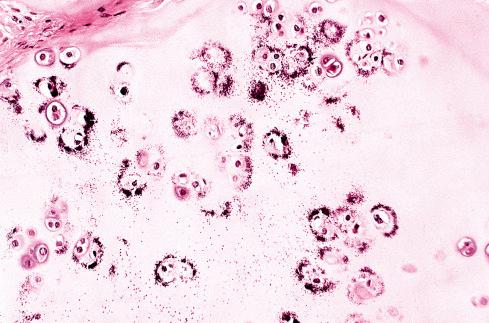
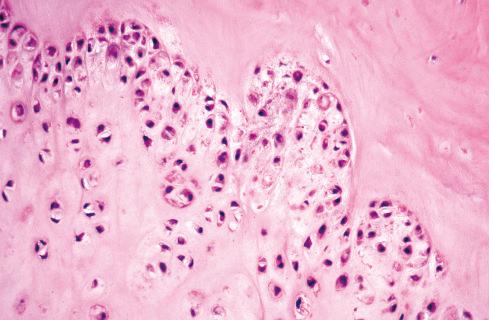
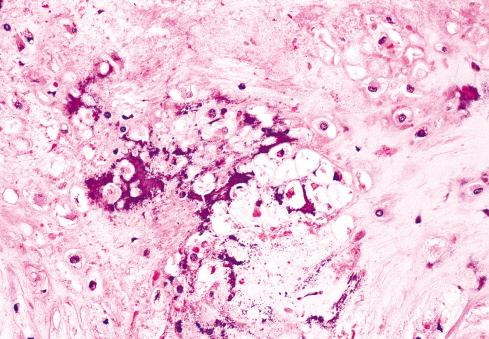
A striking feature that occurs in about 15% of cases is a granuloma-like proliferation of epithelioid and multinucleated giant cells, reminiscent of a fibroxanthoma or giant cell tumor ( Figs. 30.6 and 30.7 ). This proliferation is most conspicuous at the tumor margin and along the interlobular vascular channels. There are also rare extraskeletal chondromas in which plump, immature-appearing cells are set in a myxoid background, thereby simulating a chondrosarcoma. In general, however, these tumors can be recognized as chondromas by the presence of more mature, less cellular cartilaginous areas at the periphery. Other examples exhibit features that closely simulate those of chondroblastoma.
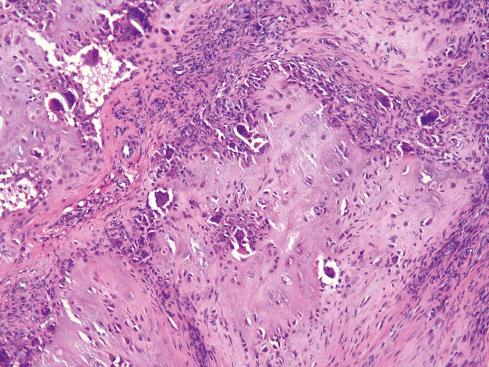
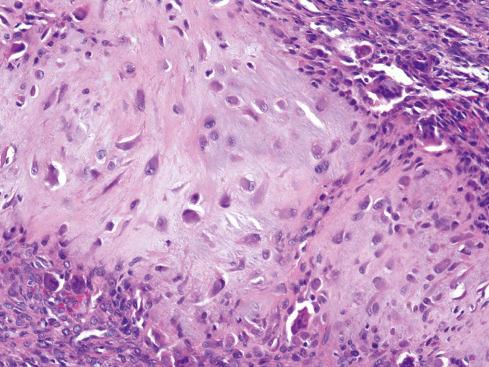
As with normal chondrocytes, the cells of the extraskeletal chondroma are positive for S-100 protein. The matrix is rich in types I and III collagen, whereas types II and IV collagen seem to be reduced. Interestingly, like other chondrogenic tumors, this lesion consistently shows nuclear expression of ERG.
Clonal chromosomal abnormalities have been identified in some extraskeletal chondromas, including monosomy 6, trisomy 5, and rearrangements of chromosome 11. Sakai et al. described a rare case of extraskeletal chondroma with three clones, including t(6;12)(q12;p11.2), t(3;7)(q13;p12), and der(2)t(2;18)(p11.2;q11.2). More recent reports have also shown aberrations of 12q13-15, particularly involving the IDH1 gene.
Distinction from other benign lesions should not be difficult in most cases. Calcifying aponeurotic fibroma is characterized by short, barlike foci of cartilaginous metaplasia in a dense, poorly circumscribed fibromatous background. It occurs in the hand rather than the distal portion of the digits and almost always affects patients younger than 25 years. Tumoral calcinosis may mimic a heavily calcified chondroma, but it lacks cartilage and usually shows a distinct histiocytic response to the calcified material. Giant cell tumor of tendon sheath has a more uniform cellular pattern and rarely has metaplastic cartilage or bone. Radiography usually allows distinction from periosteal or juxtacortical chondroma , as well as subungual osteochondroma. A small, well-circumscribed tumor located underneath the periosteum, periosteal/juxtacortical chondroma causes erosion of the underlying cortex, with ledges or buttresses at the margin of the tumor. In contrast to extraskeletal osteochondroma, subungual osteochondroma is characterized by cartilage overlying well-developed bone—features that also separate it from subungual exostosis and bizarre parosteal osteochondromatous proliferation (BPOP). Tenosynovitis with psammomatous calcification tends to involve the fingers and toes, often in patients with a history of repetitive trauma, and shows distinctive psammomatous calcifications.
Another lesion in this differential diagnosis has been called “myxochondroid metaplasia of the plantar foot.” Associated with variably painful soft tissue swelling, this lesion arises in patients of any age (including children) in the subcutaneous plantar soft tissues of the feet, sometimes also involving the toes. Histologically, it is characterized by a partially circumscribed, variably cellular proliferation of cytologically bland spindle cells, deposited in a fibromyxoid stroma with occasional foci of chondroid metaplasia. The latter foci stain for both S-100 protein and ERG, consistent with true cartilaginous differentiation. These lesions do not locally recur, even with incomplete excision. This is likely a reparative/reactive process secondary to chronic mechanical stress. The lesion has also been recognized anecdotally at other anatomic sites with a similar clinical history.
Synovial chondromatosis differs from extraskeletal chondroma by its occurrence in large joints (e.g., knee, hip, elbow, shoulder) and the formation of numerous small, metaplastic cartilaginous or osteocartilaginous nodules of varying size. Attached to the synovial membrane of the joint, tendon sheath, or lining of the adjacent extraarticular bursa ( Figs. 30.8 to Fig. 30.10 ), these synovial nodules often become detached and are found as loose bodies in the joint space. Some are hypercellular with clustering of tumor cells and increased mitotic activity. Most become calcified or ossified and can be readily demonstrated by routine radiography as multiple small, discrete radiopaque bodies ( loose bodies or joint mice ). Nonmineralized loose bodies are demonstrable on arthrograms, computed tomography (CT) scans, bone scans, or magnetic resonance imaging (MRI) as multiple filling defects outlined by contrast material. As in extraskeletal chondromas, hypercellularity, binucleate cells, and nuclear atypia are compatible with a benign clinical course. However, rare instances of chondrosarcoma arising in synovial chondromatosis have been reported.
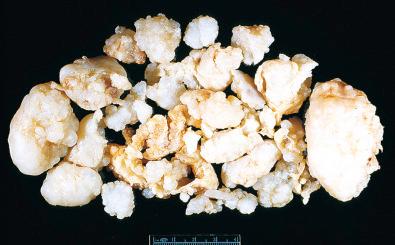
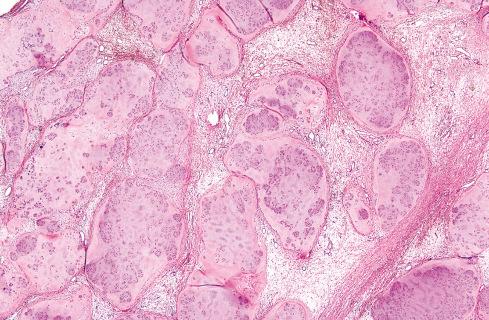
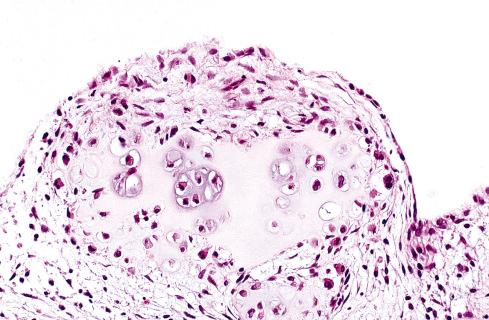
Drawing a sharp line between extraskeletal myxoid chondrosarcoma, the myxoid variant of extraskeletal chondroma, and tumoral calcinosis may be difficult, especially with those rare tumors that exhibit a moderate degree of cellular pleomorphism. Usually, however, the cartilage cells of extraskeletal chondromas are better differentiated, especially in the peripheral portion of the tumor. They also tend to be less cellular and smaller, and, as a rule, they occur in the soft tissues of the hands and feet, unusual locations for extraskeletal myxoid chondrosarcoma. A significant subset of extraskeletal myxoid chondrosarcomas show evidence of a t(9;22) or t(9;17), and analysis by fluorescence in situ hybridization (FISH) or reverse-transcriptase polymerase chain reaction (RT-PCR) for evidence of an aberration of the gene NR4A3 (chromosome 9) or EWSR1 (chromosome 22) can be helpful in difficult cases. Tumoral calcinosis does not show well-formed cartilage and consists of amorphous, deeply basophilic calcified debris.
Although some of the chondroblastic or myxoid forms of extraskeletal chondroma cause concern because of their atypical cellular features, there is no evidence that these tumors behave differently from the well-differentiated forms composed of adult-type hyaline cartilage. Overall, up to 15% of cases recur locally. It is noteworthy that transformation of extraskeletal chondroma to chondrosarcoma has never been encountered, although this is by no means rare with the chondroid lesions of bone. Local excision is the preferred mode of therapy.
Mesenchymal chondrosarcoma is a malignant cartilaginous tumor composed of two components: sheets of primitive mesenchymal cells and interspersed islands of well-differentiated hyaline cartilage. Because of the latter, mesenchymal chondrosarcoma has traditionally been considered a variant of chondrosarcoma. More recent data suggest that this is a translocation-associated sarcoma. Because of its prominent vascular pattern, several cases reported in the earlier literature were initially interpreted as “hemangiopericytoma with cartilaginous differentiation.” Mesenchymal chondrosarcoma is a rare tumor that occurs two to three times more often in bone than in soft tissue. Unlike extraskeletal myxoid chondrosarcoma, it is a rapidly growing tumor with a high incidence of metastasis.
This neoplasm differs from other forms of chondrosarcoma by its preponderance in young adults 15 to 35 years old and its slightly more frequent occurrence in females. The tumor may also occur in young children and has been described as a congenital lesion. The principal anatomic sites of mesenchymal chondrosarcoma are the head and neck region (particularly the orbit), cranial and spinal dura mater, and occipital portion of the neck, followed by the lower extremities, especially the thigh. Rare examples of this tumor have been described in virtually every anatomic site.
Orbital lesions tend to produce exophthalmos, orbital pain, blurring of vision, and headaches. Intracranial and intraspinal tumors are accompanied by vomiting, headaches, and various motor and sensory defects. Tumors in the extremities usually manifest as a painless, slowly enlarging mass, situated in the musculature. Metastasis from a primary mesenchymal chondrosarcoma of bone has mimicked a soft tissue tumor in reviewed cases. Therefore, a bone survey is essential, particularly when the tumor occurs in an unusual location. In most cases, radiography reveals a well-defined soft tissue mass, often with irregular radiopaque stipplings, arcs, flecks, or streaks due to focal calcification or bone formation in cartilaginous areas. CT scans, MRI, and angiography are helpful for outlining the tumor before surgical therapy.
Grossly, mesenchymal chondrosarcoma presents as a multilobulated, circumscribed mass that shows considerable variation in size. Cut sections show a mixture of fleshy, soft, gray-white tissue with scattered foci of irregularly sized cartilage and bone. At times, there are also small areas of hemorrhage and necrosis, but hemorrhage is much less prominent than in extraskeletal myxoid chondrosarcoma.
Microscopically, mesenchymal chondrosarcoma exhibits a characteristic pattern that consists of sheets of undifferentiated round, oval, or spindle-shaped cells, typically with an abrupt transition to small, well-defined nodules of well-differentiated hyaline cartilage. The cartilage is frequently associated with central calcification and ossification ( Figs. 30.11 to 30.13 ). The undifferentiated cells range in appearance from round to oval to slightly spindled ( Figs. 30.14 to Fig. 30.16 ). They may be arranged in nests, sheets, or a classic pericytic pattern around the sinusoidal vessels. Solid cellular and richly vascular patterns may be present in different portions of the same neoplasm. The cartilaginous foci are usually well defined, but there are also poorly circumscribed cartilaginous areas that gradually blend with the undifferentiated tumor cells. Spindle cell areas, with or without collagen formation, are present in some cases but are rarely a prominent feature.
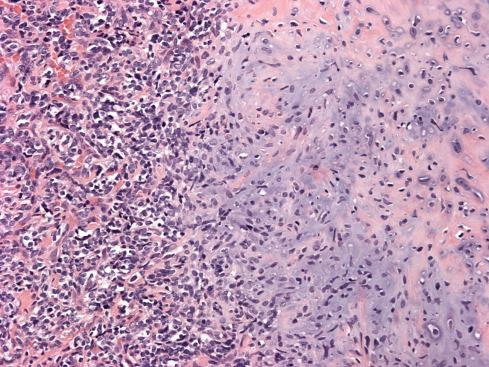
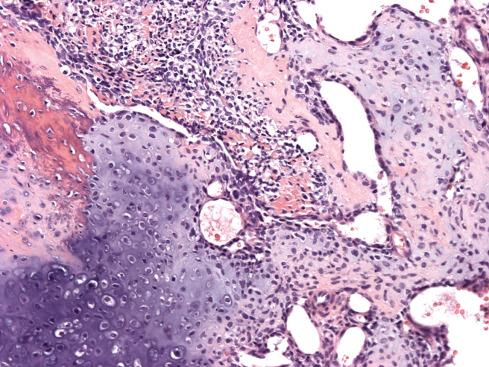
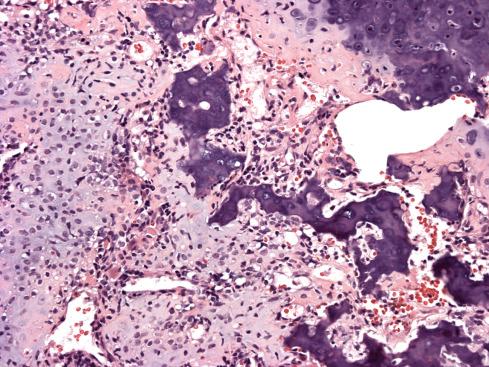
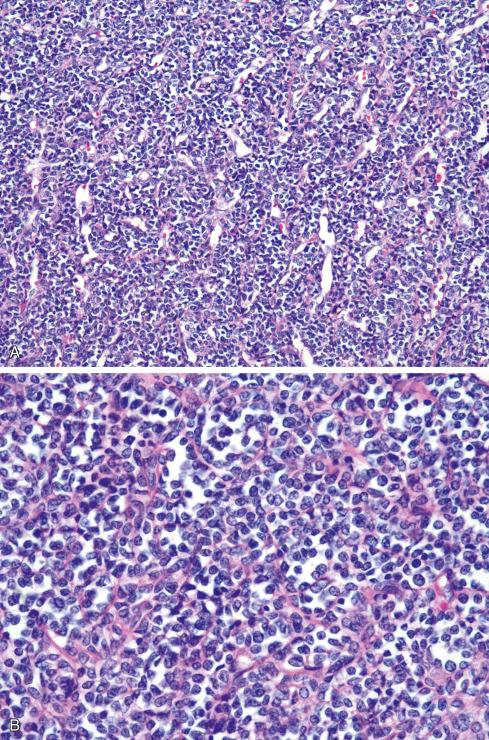
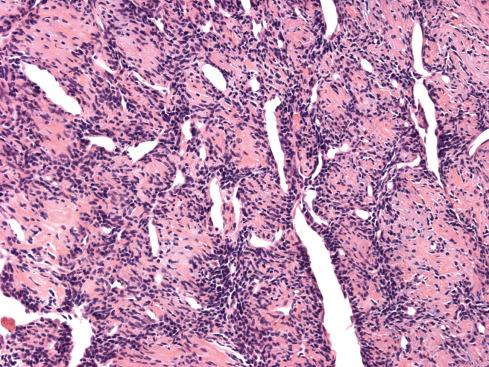
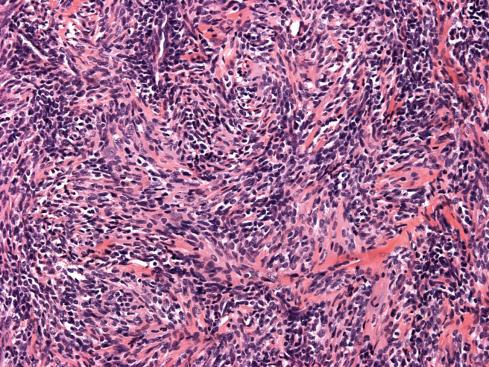
On immunohistochemistry (IHC), the cartilaginous portion of the tumor typically shows strong S-100 protein positivity, whereas only isolated cells in the undifferentiated areas stain for this antigen. The round cells typically do not stain for broad-spectrum keratins, but up to 35% show focal epithelial membrane antigen (EMA) staining. Desmin expression, along with aberrant expression of MyoD1 and less often myogenin, are seen in many mesenchymal chondrosarcomas, a potentially significant diagnostic pitfall when the differential diagnosis includes spindle cell/sclerosing rhabdomyosarcoma. This likely is related to activation of the myogenic differentiation pathway by the HEY1-NCOA2 fusion protein.
In the absence of the cartilaginous foci, the undifferentiated areas may closely resemble other round cell sarcomas, particularly Ewing sarcoma. Although early reports on the MIC2 gene (CD99) product indicated that the undifferentiated areas of extraskeletal mesenchymal chondrosarcoma were negative for this antigen, Granter et al. subsequently found that all 11 of their cases showed strong membranous immunoreactivity for CD99 in these undifferentiated areas. Similarly, Hoang et al. found CD99 staining in 17 of 21 cases. These divergent findings likely result from the use of different antibodies and different antigen-retrieval techniques. In our experience, consistent CD99 membranous immunoreactivity has been found in mesenchymal chondrosarcoma, and therefore this marker does not allow distinction of extraskeletal mesenchymal chondrosarcoma from Ewing sarcoma. To add to this confusion, NKX2-2, a nuclear marker found in almost all cases of Ewing sarcoma, is expressed in up to 75% of cases of extraskeletal mesenchymal chondrosarcoma. However, FLI1, a marker found in many, but not all, cases of Ewing sarcoma, is typically negative in mesenchymal chondrosarcoma.
Wehrli et al. reported on the utility of Sox9, a transcription factor thought to be a master regulator of chondrogenesis, in distinguishing mesenchymal chondrosarcoma from other small round blue cell tumors. In their study, 21 of 22 mesenchymal chondrosarcomas showed nuclear staining in both the primitive mesenchymal cells and the cartilaginous component. All other types of small round blue cell tumors were negative for this antigen. Similarly, several other studies also found consistent Sox9 staining in mesenchymal chondrosarcoma. Notably, mutations in IDH1 and IDH2 have not been identified in mesenchymal chondrosarcoma, which distinguishes them from central and periosteal chondrosarcomas.
A novel, recurrent HEY1-NCOA2 [(8;8)(q21;q13)] fusion in mesenchymal chondrosarcoma has been consistently identified in mesenchymal chondrosarcoma. Wang et al. found that all 9 cases of mesenchymal chondrosarcoma showed evidence of this fusion by either RT-PCR or FISH, but 15 samples of other types of chondrosarcoma lacked this fusion.
Although typical mesenchymal chondrosarcomas pose no particular diagnostic problem, recognition of this tumor may be difficult with small biopsy or needle biopsy specimens that demonstrate only one of the two tissue elements. In particular, tumors without the cartilaginous element may be easily mistaken for Ewing sarcoma or poorly differentiated synovial sarcoma with a prominent hemangiopericytoma-like vascular pattern. Metaplastic cartilage may occur in poorly differentiated synovial sarcoma, but it is much less common than foci of calcification or bone. Careful search for a biphasic pattern or epithelial differentiation with antibodies for cytokeratin or EMA may be helpful, but molecular analysis allows for a more definitive separation. Because CD99 and NKX2-2 do not allow distinction of mesenchymal chondrosarcoma from Ewing sarcoma or even poorly differentiated synovial sarcoma, molecular analysis for evidence of EWSR1, SYT, or NCOA2 aberrations can be extremely useful.
Distinction from differentiated forms of extraskeletal chondrosarcoma may also cause some diagnostic difficulty. These rare tumors, however, always display a more uniform pattern and lack the contrasting differentiated and undifferentiated areas.
The distinction of mesenchymal chondrosarcomas showing expression of rhabdomyoblastic markers from spindle cell/sclerosing rhabdomyosarcoma may be extremely challenging, particularly if cartilage has not been sampled in a needle biopsy. The presence of calcifications radiologically should suggest mesenchymal chondrosarcoma. In difficult cases, molecular genetic study for the HEY1-NCOA2 fusion may be required.
Become a Clinical Tree membership for Full access and enjoy Unlimited articles
If you are a member. Log in here